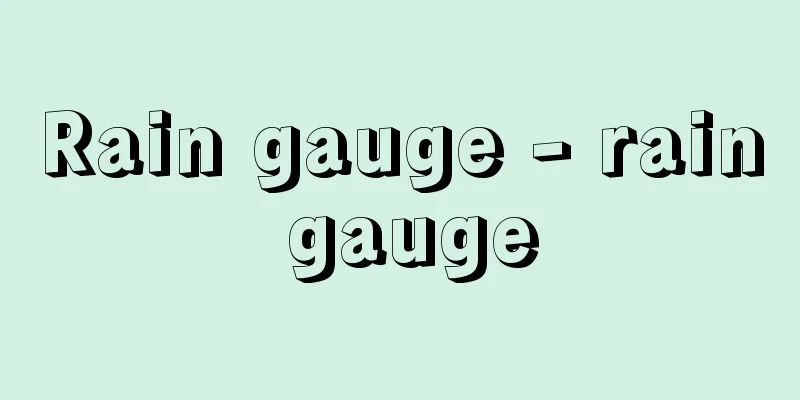Rain gauge - rain gauge

|
An observation instrument used to measure precipitation. The simplest type is a metal cylinder with a bottom, placed vertically in an open space. The depth of the precipitation accumulated inside is measured with a ruler, or the water volume or weight is measured. It is also called a rain and snow gauge. The standard rain gauge in Japan has an aperture of 20 centimeters, and the water outlet is placed several tens of centimeters above the ground. To measure rainfall accurately, choose a location that is not affected by buildings, etc., and plant grass around it to prevent raindrops from bouncing off. There are various types of rain gauges depending on the purpose of use. For indoor recording, tipping bucket type rain gauges are often used. Rainwater that enters the water receiver is poured into one side of a tipping bucket that moves like a seesaw around a rotating axis. When it reaches a certain amount, for example 0.5 mm of rainfall, the bucket tips over and the water is drained. When it tips over, a switch is activated, which starts a recorder placed inside the room. Devices that record this signal remotely using wires or wirelessly are also called robotic rain gauges. The amount of rainfall over a very short period of time is measured by dropping rainwater from the water receiver through a nozzle into kerosene and counting the number of times the light beam is interrupted. Some rain gauges use electric heaters, hot water, antifreeze, etc. to prevent freezing. Rainfall observations are said to have been carried out as early as the 4th century BC in India, but the earliest known historical documents include records taken with a rain gauge in Korea in the mid-15th century. [Takeji Shinohara] [Reference] |The rainwater collected in the receiver passes through a funnel and accumulates in a water storage bottle. The rainwater that accumulates in the water storage bottle is transferred to a rain gauge to measure the amount of rain. ©Shogakukan "> Structure of a reservoir-type indicating rain gauge This is an instrument that remotely records the amount of rainfall. When rainwater enters through a 20cm diameter water inlet and accumulates in the tipping bucket to a depth of 0.5mm, the bucket tips over and records the number of times it tips over via a lead wire in an indoor recorder (self-connected meter). ©Shogakukan "> Structure of a tipping bucket type automatic rain gauge Source: Shogakukan Encyclopedia Nipponica About Encyclopedia Nipponica Information | Legend |
|
降水量を測るために使用する観測計器。いちばん簡単なものは、底のある金属製円筒を、空地などに鉛直に設置したものである。中にたまった降水の深さを物差しで測るか、水量あるいは重さを測定する。雨雪量計ともよばれる。日本で標準とされている雨量計は、口径が20センチメートルで、受水口は地面から数十センチメートルにする。正確に雨量を測るには、建物などの影響がない場所を選び、雨滴の跳ね返りを防ぐため、周囲には芝草などを植えるのがよい。 利用目的に応じていろいろな雨量計がある。室内で記録させるには、転倒ます型自記雨量計がよく用いられる。受水器に入った雨水は、回転軸を中心にしてシーソーのように動く転倒ますの片方に注ぐ。それがある量、たとえば雨量で0.5ミリメートルに達すると、ますが転倒して排水される。転倒時にスイッチが作動し、室内に置いた記録器が動く。この信号を有線あるいは無線を使って遠方に記録する装置は、ロボット雨量計ともよばれる。ごく短い時間の雨量は、受水器からの雨水をノズルを通して灯油の中に滴下し、光ビームの断続をカウントして測る。凍結を防ぐため電気ヒーター、温水、不凍液などを使う雨量計もある。 雨量の観測は、すでに紀元前4世紀ごろインドで行われたというが、史料に残っているものでは15世紀の中ごろ朝鮮での雨量計による記録が知られている。 [篠原武次] [参照項目] |受水器で受けた雨水は、漏斗を通って貯水瓶にたまる。貯水瓶にたまった雨水を雨量ますに移して雨量を測る©Shogakukan"> 貯水型指示雨量計の構造 降水量を遠隔記録する計器で、口径20cmの受水口から入ってきた雨水が転倒ますに0.5mmたまると、ますは転倒して、そのつどリード線を通して屋内の記録器(自己電接計)にその転倒回数を記録する仕組みになっている©Shogakukan"> 転倒ます型自記雨量計の構造 出典 小学館 日本大百科全書(ニッポニカ)日本大百科全書(ニッポニカ)について 情報 | 凡例 |
>>: Uryuudo Ruins - Uryuudo Ruins
Recommend
Roman Aqueduct
In ancient Rome, from its city-state period throu...
Lake Kamaki
This artificial lake is located in the southwest ...
Yukishige Aoyama
1815-1863 A daimyo in the late Edo period. Born o...
Woman in a Decorative Window
...The constitutional capital of the Netherlands ...
Karman vortex street
When a cylindrical object is moved through a flui...
Xanthophyll - Kisantofil (English spelling) xanthophyll
A type of carotenoid, a general term for a group ...
Metallized water
…Below that is a layer of high-pressure liquid hy...
Mount Hotaka
Located on the border between Nagano and Gifu pre...
Pachacámac (English spelling)
These temple ruins are located in the Lurin River ...
Mantaro Kido
Born: July 1, 1893 in Matsuyama [Died] November 18...
Ishiwaki Port
A port in Yurihama-cho, Tohaku-gun, Tottori Prefec...
Shigin - Reciting poetry
Reciting Chinese poetry with a melody. Some peopl...
Yokoi Tokiyoshi
A representative agronomist of modern Japan. Born...
Index - Indekusu
…Words (linguistic signs) are the “signals of sig...
Court martial - Gumpoukaigi
A military court is a special criminal court belo...









